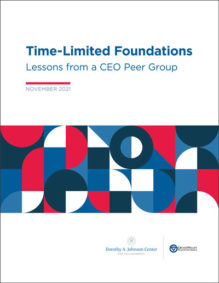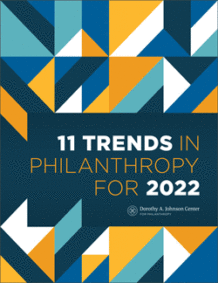Four Key Distinctions to Help Make Sense of a Complex Philanthropic Universe


There’s an old saying in philanthropy: If you know one foundation, you know one foundation. The same can be said for other types of nonprofit organizations. Each organization in this sector is in some way unique. Even as many of us share critical mission areas, service geographies, partnerships, and organizational structures, how we do our work can vary enormously.
This all means there is incredible diversity and complexity in the nonprofit universe. This can be especially intimidating to newcomers, in particular, because this field is also chock full of jargon and concepts that are often vague, confusing, used in multiple ways, and misunderstood or misused.
To help navigate this complex landscape, I’m highlighting four simple yet key distinctions. These can contribute to a better understanding of the philanthropic sector by classifying organizations into broad types. And specifying those types reveals some of the key underlying factors — and central debates — shaping this field. It also helps counter some popular, but wrong misconceptions about nonprofits and foundations.
The list below is not exhaustive; there are many more choices and strategies that go into thoughtfully organizing and pursuing the work of social good, and many more means of defining goals, making gifts, organizing staff, or setting time horizons. Also, some of these distinctions are better seen as continua rather than either/or choices. I welcome your additions to this list and the stories of how you and your partners have chosen to move in one direction or another.
Any tax-exempt entity classified under Section 501(c)(3) of the Internal Revenue Code is further sub-classified as either a public charity or a private foundation.
Both categories are tax-exempt, and both may receive tax-deductible contributions. However, each category also has distinct features, as well as legal restrictions and requirements.
Private foundations are usually funded by a single primary source — for instance, the wealth of a single individual or corporation, or ongoing contributions from multiple members of a family — while public charities must meet a public support test by raising funds from the multiple public sources, such as donations from individuals or government or foundations, as well as fees they might charge.
By default, all entities that apply for 501(c)(3) status are treated as private foundations unless and until they are able to meet the public support test. But there are many more public charities than private foundations.
Finally, to remind us of the complexity in this field, we need to point out that not every organization with “foundation” in its name is legally a private foundation. Community foundations are public charities, for example, as are many “foundations” set up by celebrities to raise funds for a certain cause — e.g., the Michael J. Fox Parkinson’s Foundation for Parkinson’s Research is a public charity.
Contrary to a popular misconception, not all grantmaking institutions (regardless of whether they are legally a public charity or a private foundation) have endowments — i.e., an accumulation of invested assets from which they draw the funds to make grants, loans, or other philanthropic transfers (and to pay their operating expenses). Some grantmakers are created and operate with minimal or no endowment and instead receive or raise new funds on a periodic basis to support their grantmaking and operations — we usually call these “pass-through” institutions.
This is one of those distinctions that is really a continuum rather than two separate boxes. On one end are endowed entities receiving no additional contributions in a given year (outside of interest from investing the endowment) and paying out a certain amount from that endowment in that year (the legal minimum payout for private foundations is 5% of net assets). On the other end are entities without any endowed assets who contribute 100% of newly received funds each year, “passing through” those funds to other entities they want to support. In between are many organizations that maintain some endowment and receive new contributions in a year, making grants from the combination of these sources.
Note that this continuum applies to donor-advised funds, too. Also note that endowed and pass-through institutions can both be set up to run in perpetuity or for a limited term. This brings us to our next key distinction to help make sense of the complexity…
Grantmaking institutions vary in the time horizon for their operations. While many are intended to exist “in perpetuity,” either with a permanent endowment or not, many have a set limit to their lifespan or may have rules in place for determining the right time to cease operations and close the institution, a phenomenon often called sunsetting or spending down.
The methods for how to limit the life of a grantmaking institution vary. For some limited-life pass-through institutions, this will look like simply shutting down grantmaking, ceasing new contributions, and closing up shop. For some endowed institutions, they might distribute the remaining endowment principal to one or more recipients in large final gift(s), or they might gradually distribute more and more of the principal over several years. Others might have end-of-life plans for the organization that involve transferring the operations and assets to another entity such as a community foundation.
The decision about whether to be an in-perpetuity or limited-life institution can be made at creation or it can be made/modified after years of operation. Michigan’s Erb Family Foundation, for example, recently announced its transition from a perpetual foundation to a limited-life foundation. Sometimes this decision is explicitly left to later generations. Reasons for making one decision or another also vary. And, again, note that this distinction also applies to donor-advised funds — the decision must be made whether to be eternal or to sunset.
 Resource Spotlight: A Closer Look at Limited-Life Foundations
Resource Spotlight: A Closer Look at Limited-Life Foundations
Time-Limited Foundations: Lessons from a CEO Peer Group provides insights into the day-to-day leadership and management of these foundations. For foundations or donors considering whether to have a defined lifespan for their giving, this resource provides insights into the practical implications of that decision.
Another common misconception is that all nonprofit organizations have paid staff. For sure, many well-known private foundations — such as the Michael and Susan Dell Foundation, Bill and Melinda Gates Foundation, and the Ford Foundation — have impressively large staffs and offices all over the world. But among foundations, these are the exception, not the rule.
While all IRS-classified private foundations must have a governing board, the vast majority of grantmaking institutions have no paid staff (part- or full-time) in the traditional sense. Many are operated through some combination of trustees (who can be volunteers or receive a stipend), paid advisors (e.g., attorneys, wealth or investment managers, philanthropic advisors), and volunteers (including trustees who volunteer extra time to perform staff functions). There are even companies like Foundation Source and other organizations that are paid to perform some or all of the day-to-day staff functions (e.g., charitable, administrative, investment) for a grantmaking institution that usually has no paid staff of their own.
The percentage of public charities that have no paid staff is not nearly as high as it is for foundations, but there are still a great many. We probably all know a grassroots nonprofit that describes itself as volunteer-run. If we include organizations that are not officially registered with the IRS, but that still provide services or engage in advocacy, this distinction becomes even more important.
 Resource Spotlight: Innovations in Talent Investment for Individuals, Organizations, and Communities
Resource Spotlight: Innovations in Talent Investment for Individuals, Organizations, and Communities
In this piece from our 11 Trends in Philanthropy for 2022 report, the authors explore how nonprofits and foundations are increasingly investing in their talent through options like fellowships, remote work, sabbaticals, and distributed leadership models.
Terms & Definitions
Primers & Explainers
Workshops & Webinars